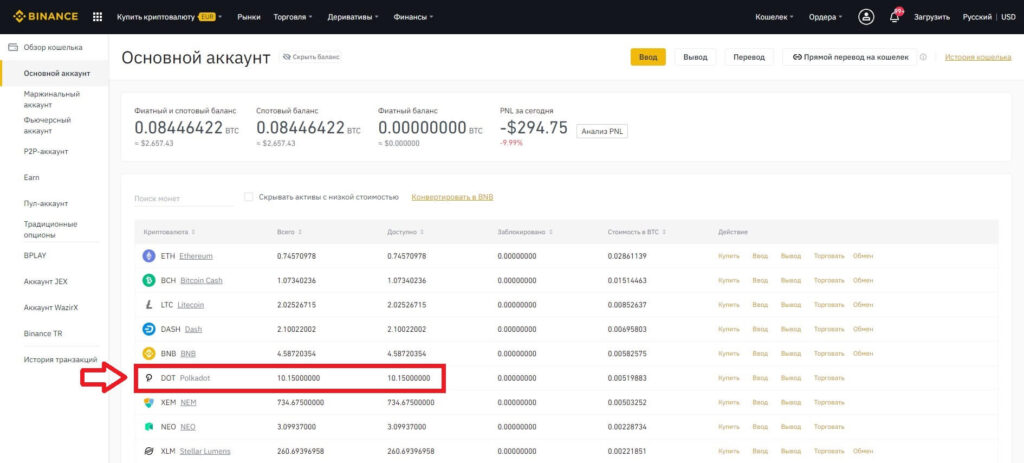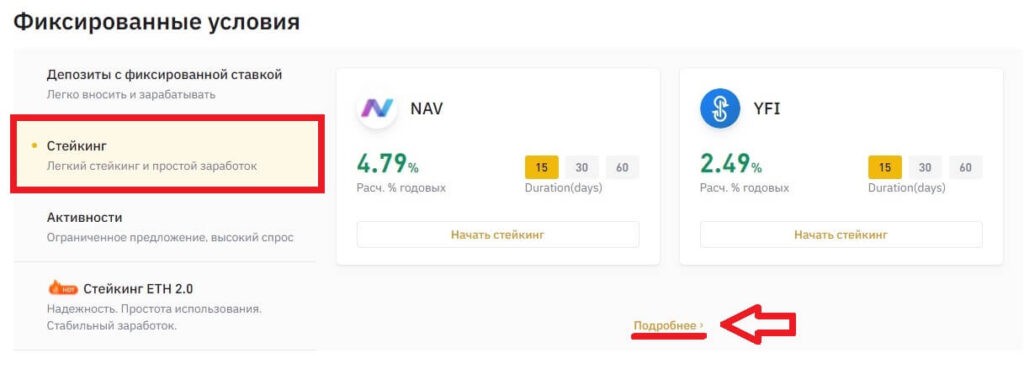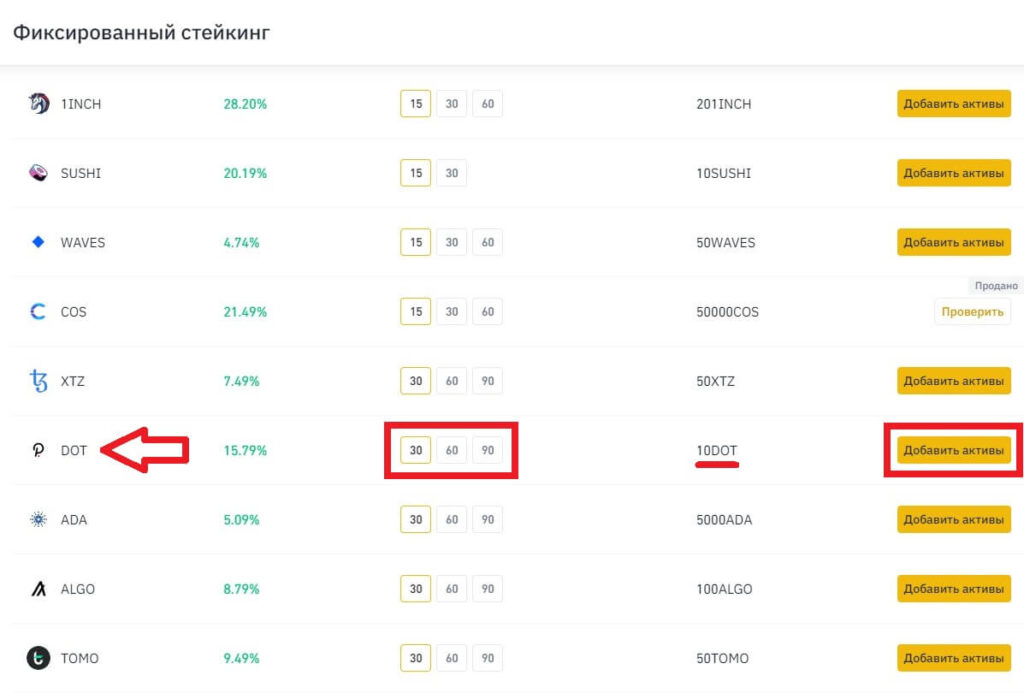Polkadot (DOT) | Руководство по стекингу
Polkadot — это многоцепочный протокол с открытым исходным кодом, облегчающий передачу любых данных или активов между цепями и обеспечивающий взаимодействие блокчейнов друг с другом. Протокол Polkadot соединяет публичные, частные сети, сети без разрешения.
DOT — токен, используемый в сети polkadot. Токен DOT служит трем различным целям: управление сетью, стекинг и связывание.
Пользователи могут легко ставить токены DOT на MyCointainer и получать пассивный доход с помощью нескольких простых кликов.
Ознакомьтесь с пошаговым руководством стекинга Polkadot (DOT):
- Новые пользователи регистрируются на https://www.mycointainer.com/signup/, зарегистрированные пользователи входят на https://www.mycointainer.com/
- После входа в систему выберите вариант депозита
3. Выберите «У меня уже есть монеты» и найдите в списке Polkadot (DOT).

4. Выбрав Polkadot (DOT), нажмите «Создать адрес».
5. Поместите токен DOT на указанный адрес. Как только ваш депозит будет успешным, начнется получение вознаграждения за стейкинг.
Используя планы Power MyCointainer, получите все 100% вознаграждения. 0% комиссии за все активы. Посетите MyCointainer POWER PLANS
Staking
Polkadot uses NPoS (Nominated Proof-of-Stake) as its consensus mechanism. The system encourages DOT holders to participate as nominators. Nominators may back up to 16 validators as trusted validator candidates. Both validators and nominators lock their tokens as collateral and receive staking rewards.
The staking system pays out rewards essentially equally to all validators regardless of stake. Having more stake on a validator does not influence the amount of block rewards it receives. However, there is a probabilistic component to reward calculation (discussed below), so rewards may not be exactly equal for all validators in a given era.
Distribution of the rewards are pro-rata to all stakers after the validator’s commission is deducted. In this way, the network creates incentives for the nomination of lower-staked validators to create an equally-staked validator set.
How does staking work?
1. Identifying which role you are
In staking, you can be either a nominator or a validator.
As a nominator, you can nominate validator candidates that you trust to help you earn rewards in the chain’s native token. The earned rewards can be bonded (locked) immediately for staking on your account, which would effectively compound the rewards you receive over time. You could also choose to have them deposited to your account or a different account as free (transferable) balance. You can take a look at the nominator guide to understand your responsibilities as a nominator, and the validator docs to understand what you need to do as a validator.
If you are a beginner and would like to securely stake your tokens using Polkadot JS Apps, watch the video below.

2. Staking System Overview
Any potential validators can indicate their intention to be a validator candidate. Their candidacies are made public to all nominators, and a nominator in turn submits a list of up to 16 candidates that it supports. In the next era, a certain number of validators having the most DOT backing get elected and become active. As a nominator, a minimum of 10 DOT is required to submit an intention to nominate. The nomination intents are placed in a semi-sorted list called bags-list.
Minimum Nomination to Receive Staking Rewards
Although the minimum nomination intent is 10 DOT, it does not guarantee staking rewards. The nominated amount has to be greater than minimum active nomination, which is a dynamic value that can be much higher than 10 DOT.
The bags list has two primary components, bags and nodes. The list is composed of bags that each describe a range of active bonded funds (e.g. the 1st bag will have nominators with 0 → 10 DOT, 2nd bag 11 → 20 DOT, etc). In each bag is a list of nodes that correspond to a nominator and their staked funds.
The bags-list pallet is designed to be self-maintaining, with minimal effort from the blockchain, making it extremely scalable. Let us explore the sorting functionality of the bags list with an example. In the bags list below, there are 8 nodes placed in 3 bags. It can be observed that the list of nodes within the bags are arranged based on their insertion order and not based on the number of tokens bonded. For instance, the nodes in bag 1 are arranged in this order: 15 → 12 → 19

Let’s say the nominator with the stake of 19 DOT bonds 2 DOT additionally. This action would place that nominator node in bag 2, right after the node with 27 DOT.
Actions like bonding/unbonding tokens automatically rebags the nominator node, but events like staking rewards/slashing do not! The bags-list pallet comes with an important permissionless extrinsic: rebag . This allows anyone to specify another account that is in the wrong bag, and place it in the correct one. Check the bags-list section for more information.

This sorting functionality is extremely important for the long-term improvements of the staking/election system. The bags-list is capable of including an unlimited number of nodes, subject to the chain’s runtime storage. In the current staking system configuration, the bags list keeps 50000 nomination intents, of which, at most 22,500 come out as the electing nominators. Check Staking Election Stages section for more info.
Minimum active nomination threshold to earn rewards is dynamic
Once again, submitting a nomination intent does not guarantee staking rewards. The stake of the top 22,500 nominators is applied to the validators in the active set. To avail staking rewards, ensure that the number of tokens bonded is higher than the minimum active nomination. For more information, check the nominator guide
Once the nomination period ends, the NPoS election mechanism takes the nomination intents and their associated votes as input, and outputs a set of validators. The bags are iterated from the most staked to the least staked. This could leave the last touched bag to only be partially iterated. This means that in some edge cases, the order of members within a bag is also important. Recall that within each bag, the iteration order is simply the insertion order. If only 7 nodes have to be picked for the electing set, the nodes with 5 and 7 DOT will be selected and will the node with 8 DOT will be left out. The bags-list pallet comes with an extrinsic: putInFrontOf which helps the node to move up in the bag. Check the bags-list section for more information.

The «election solution» has to meet certain requirements, such as maximizing the amount of stake to nominate validators and distributing the stake backing validators as evenly as possible. The objectives of this election mechanism are to maximize the security of the network, and achieve fair representation of the nominators. If you want to know more about how NPoS works (e.g. election, running time complexity, etc.), please read here.
We expect each nominator to carefully track the performance and reputation of the validators they back. Nominating is not a «set and forget» operation.
3. Staking Rewards Distribution
To explain how rewards are paid to validators and nominators, we need to consider validator pools. A validator pool consists of the stake of an elected validator together with the nominators backing it.
If a nominator n with stake s backs several elected validators, say k , the NPoS election mechanism will split its stakes into pieces s_1 , s_2 , …, s_k , so that it backs validator i with stake s_i . In that case, nominator n will be rewarded essentially the same as if there were k nominators in different pools, each backing a single validator i with stake s_i .
For each validator pool, we keep a list of nominators with the associated stakes.
The general rule for rewards across validator pools is that two validator pools get paid essentially the same amount of tokens for equal work, i.e. they are NOT paid proportional to the stakes in each pool. There is a probabilistic component to staking rewards in the form of era points and tips but these should average out over time.
Within a validator pool, a (configurable) percentage of the reward goes to pay the validator’s commission fees and the remainder is paid pro-rata (i.e. proportional to stake) to the nominators and validator. Notice in particular that the validator is rewarded twice: once in commission fees for validating (if their commission rate is above 0%), and once for nominating itself with stake. If a validator’s commission is set to 100%, no tokens will be paid out to any nominations in the validator pool.
To estimate the inflation rate and how many tokens you can get each month as a nominator or validator, you can use this tool as a reference and play around with it by changing some parameters (e.g. how many days you would like to stake with your DOT, provider fees, compound rewards, etc.) to have a better estimate. Even though it may not be entirely accurate since staking participation is changing dynamically, it works well as an indicator.
4. Rewards Mechanism
We highlight two features of this payment scheme. The first is that since validator pools are paid the same regardless of stake level, pools with less stake will generally pay more to nominators per-token than pools with more stake.
We thus give nominators an economic incentive to gradually shift their preferences to lower staked validators that gain a sufficient amount of reputation. The reason for this is that we want the stake across validator pools to be as evenly distributed as possible, to avoid a concentration of power among a few validators.
In the long term, we expect all validator pools to have similar levels of stake, with the stake being higher for higher reputation validators (meaning that a nominator that is willing to risk more by backing a validator with a low reputation will get paid more).
The following example should clarify the above. For simplicity, we have the following assumptions:
Both validator pools A & B have 4 nominators with the total stake 600 and 400 respectively.
Based on the above rewards distribution, nominators in validator pool B get more rewards per DOT than those in pool A because pool A has more overall stake. Sam has staked 50 DOT in pool A, but he only gets 8.3 in return, whereas Kitty gets 12.5 with the same amount of stake.
There is an additional factor to consider in terms of rewards. While there is no limit to the number of nominators a validator may have, a validator does have a limit to how many nominators to which it can pay rewards.
In Polkadot and Kusama, this limit is currently 256, although this can be modified via runtime upgrade. A validator with more than 256 nominators is oversubscribed. When payouts occur, only the top 256 nominators as measured by amount of stake allocated to that validator will receive rewards. All other nominators are essentially «wasting» their stake — they used their nomination to elect that validator to the active stake, but receive no rewards in exchange for doing so.
We also remark that when the network slashes a validator slot for a misbehavior (e.g. validator offline, equivocation, etc.) the slashed amount is a fixed percentage (and NOT a fixed amount), which means that validator pools with more stake get slashed more DOT. Again, this is done to provide nominators with an economic incentive to shift their preferences and back less popular validators whom they consider to be trustworthy.
The second point to note is that each validator candidate is free to name their desired commission fee (as a percentage of rewards) to cover operational costs. Since validator pools are paid the same, pools with lower commission fees pay more to nominators than pools with higher fees. Thus, each validator can choose between increasing their fees to earn more, or decreasing their fees to attract more nominators and increase their chances of being elected. In the long term, we expect that all validators will need to be cost efficient to remain competitive, and that validators with higher reputation will be able to charge slightly higher commission fees (which is fair).
Accounts
There are two different accounts for managing your funds: Stash and Controller .

- Stash: This account holds funds bonded for staking, but delegates some functions to a Controller. As a result, you may actively participate with a Stash key kept in a cold wallet, meaning it stays offline all the time. You can also designate a Proxy account to vote in governance proposals.
- Controller This account acts on behalf of the Stash account, signalling decisions about nominating and validating. It sets preferences like payout account and commission. If you are a validator, it also sets your session keys. It only needs enough funds to pay transaction fees.
We designed this hierarchy of separate key types so that validator operators and nominators can protect themselves much better than in systems with only one key. As a rule, you lose security anytime you use one key for multiple roles, or even if you use keys related by derivation. You should never use any account key for a «hot» session key in particular.
Controller and Stash account keys can be either sr25519 or ed25519. For more on how keys are used in Polkadot and the cryptography behind it see here.
Validators and Nominators
Since validator slots are limited, most of those who wish to stake their DOT and contribute economic security to the network will be nominators.
Validators do most of the heavy lifting: they produce new block candidates in BABE, vote and come to consensus in GRANDPA, validate the state transition function of parachains, and possibly some other responsibilities regarding data availability and XCM.
Nominators, on the other hand, have far fewer responsibilities. Those include monitoring their validators’ performance (uptime), keeping an eye on changing commission rates (a validator can change commission at any time), and general health monitoring of their and their validators’ account. Thus, while not set-it-and-forget-it, a nominator’s experience is relatively hands-off compared to a validators.

Want to stake DOT?
- — Become a nominator on the Polkadot network. — Become a validator on the Polkadot network.
Slashing
Slashing will happen if a validator misbehaves (e.g. goes offline, attacks the network, or runs modified software) in the network. They and their nominators will get slashed by losing a percentage of their bonded/staked DOT.
Any slashed DOT will be added to the Treasury. The rationale for this (rather than burning or distributing them as rewards) is that slashes may then be reverted by the Council by simply paying out from the Treasury. This would be useful in situations such as a faulty runtime causing slashing or forcing validators offline through no fault of their own. In the case of legitimate slashing, it moves tokens away from malicious validators to those building the ecosystem through the normal Treasury process.
Validator pools with larger total stake backing them will get slashed more harshly than less popular ones, so we encourage nominators to shift their nominations to less popular validators to reduce their possible losses.
It is important to realize that slashing only occurs for active validations for a given nominator, and slashes are not mitigated by having other inactive or waiting nominations. They are also not mitigated by the validator operator running separate validators; each validator is considered its own entity for purposes of slashing, just as they are for staking rewards.
As an example, assume BIG_COMPANY has 50 validators that all go offline at the same time, thus causing a 1% unresponsiveness slash to their nominators. In this example, the nominator has nominated five validators, two of which are with BIG_COMPANY (BC_1 and BC_2) and three are with other validators that do not belong to BIG_COMPANY (OV_1, OV_2, and OV_3). In this era, BC_1 is the active validator for this nominator, BC_2 and OV_1 are inactive, and OV_2 and OV_3 are waiting. The nominator will be slashed 1% of bonded stake, since BC_1 is the active validator. The inactive and waiting validators (BC_2 and OV_1 through 3) don’t have any effect on this, since they are not actively validating. Any nominator actively nominating BC_2 also receives a 1% slash, but any nominator actively nominating OV_1 is unaffected.
In rare instances, a nominator may be actively nominating several validators in a single era. In this case, the slash is proportionate to the amount staked to that specific validator. For instance, if another nominator had their stake split 50% to BC_1 and 50% to OV_1, they would receive a slash of 0.5% (50% of 1%). If a nominator were actively nominating BC_1 and BC_2, again with 50% of their stake allocated to each, they would still end up with a 1% slash, since a 1% slash is applied to both halves of their stake. Note that you cannot control the percentage of stake you have allocated to each validator or choose who your active validator will be (except in the trivial case of nominating a single validator). Staking allocations are controlled by the Phragmén algorithm.
Once a validator gets slashed, it goes into the state as an «unapplied slash». You can check this via Polkadot-JS Apps. The UI shows it per validator and then all the affected nominators along with the amounts. While unapplied, a governance proposal can be made to reverse it during this period (7 days on Kusama, 28 days on Polkadot). After the grace period, the slashes are applied.
The following levels of offence are defined. However, these particular levels are not implemented or referred to in the code or in the system; they are meant as guidelines for different levels of severity for offences. To understand how slash amounts are calculated, see the equations in the section below.
- Level 1: isolated unresponsiveness, i.e. being offline for an entire epoch. Generally no slashing, only chilling.
- Level 2: concurrent unresponsiveness or isolated equivocation. Slashes a very small amount of the stake and chills.
- Level 3: misconducts unlikely to be accidental, but which do not harm the network’s security to any large extent. Examples include concurrent equivocation or isolated cases of unjustified voting in GRANDPA. Slashes a moderately small amount of the stake and chills.
- Level 4: misconduct that poses a serious security or monetary risk to the system, or mass collusion. Slashes all or most of the stake behind the validator and chills.
Let’s look at these offences in a bit more detail.
Unresponsiveness
For every session, validators will send an «I’m online» heartbeat to indicate they are live. If a validator produces no blocks during an epoch and fails to send the heartbeat, it will be reported as unresponsive. Slashing may occur depending on the repeated offences and how many other validators were unresponsive or offline during the epoch.
Validators should have a well-architected network infrastructure to ensure the node runs to reduce the risk of slashing or chilling. A high availability setup is desirable, preferably with backup nodes that kick in only once the original node is verifiably offline (to avoid double-signing and being slashed for equivocation — see below). A comprehensive guide on validator setup is available here.
Here is the formula for calculating slashing due to unresponsiveness:
The examples demonstrate how to calculate the slashing penalty for unresponsiveness.
Стейкинг криптовалюты Polkadot на бирже Binance
Разберём как зарабатывать на стейкинге криптовалюты Polkadot DOT. Вы узнаете как получать пассивный доход в размере 15-22% годовых просто храня монеты DOT. На подробном примере рассмотрим как отправить Polkadot в стейкинг.

Первым делом зарегистрируйтесь на бирже Binance.
Ссылка для регистрации: https://www.binance.com
Polkadot стейкинг
Для стейкинга криптовалюты Polkadot вам потребуется минимум 10 DOT. Купите монеты на бирже или заведите их на биржевой счёт.

Как отправить Polkadot в стейкинг?
Перейдите во вкладку Финансы — Binance Earn.

Далее, чтобы узнать необходимую информацию и посмотреть доступные монеты для стейкинга, нажмите Стейкинг — Подробнее.

На данной странице вам представлен список со всеми доступными монетами для стейкинга. Нажмите Посмотреть все продукты для фиксированного стейкинга. В списке находим криптовалюту DOT.

Доступен стейкинг от 30 до 90 дней. В зависимости от выбранного варианта мы можем получать определённый процент начислений на спотовый кошелёк.
- Стейкинг DOT 30 дней — 15.79%
- Стейкинг DOT 60 дней — 18.34%
- Стейкинг DOT 90 дней — 22.49%
Выбираем подходящий вариант и нажимаем жёлтую кнопку Добавить активы.

В графе Заблокировать сумму прописывам сумму для отправки в стейкинг. Минимум 10 DOT. Справа во вкладке Итого нам указана дата и время начала и завершения стекинга, расчётная доходность в процентах и расчётная ставка в DOT.
Прочитайте соглашение Binance Staking Service, поставьте галочку, если вас всё устраивает и нажмите кнопку Подтвердите покупку.
Как проверить наличие активов DOT?
Чтобы проверить наличие активов, перейдите в раздел Кошелек — Earn. Нажмите вкладку Фиксированный стейкинг — Фиксированная ставка.

Здесь отображаются все отправленные монеты в стейкинг. По окончании срока они будут отображаться на балансе в спотовом кошельке. Проценты будут начисляться также в спотовый кошелёк. Первые проценты начислят уже через пару дней!
Криптовалюта Polkadot надёжно закрепилась в ТОП 5 криптовалют по рейтингу сервиса CoinMarketCap.
Хотите узнать больше информации как зарабатывать на стейкинге криптовалют? Читайте статью Binance Staking.
Как майнить криптовалюту Polkadot?
Источник https://www.mycointainer.com/insight/ru/polkadot-staking_guide_ru/
Источник https://wiki.polkadot.network/docs/learn-staking
Источник https://cryptorelax.org/polkadot-staking/